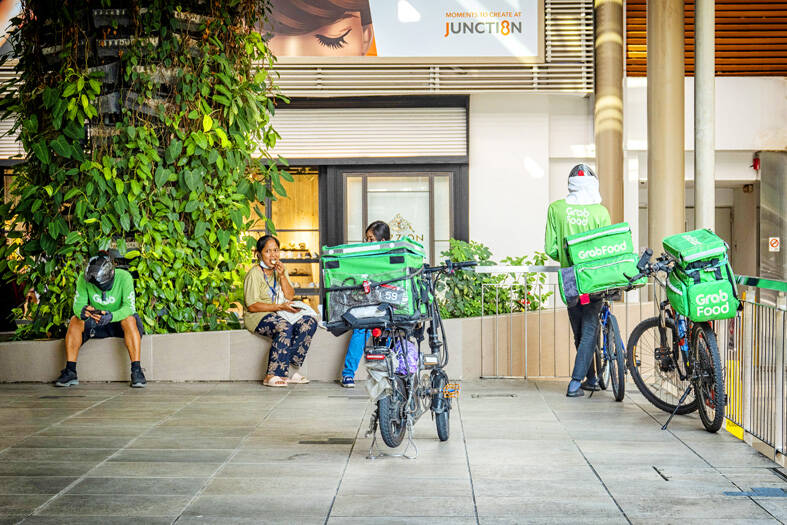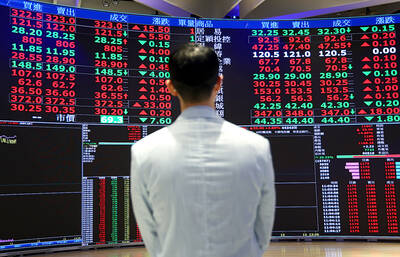Alicia quit her job at a Singapore construction firm during the COVID-19 pandemic and signed up to work for an app-based delivery company, then a ride-hailing platform. While she welcomed the flexibility, she worried about her pension, and falling sick.
She was relieved when the city-state’s government last month said it would soon introduce legislation to extend work-related injury insurance and pension coverage to delivery and ride-hailing workers from 2024 onwards.
“As a single mother, I sometimes worry about how uncertain this job can be, because I never know how much money I will make every day,” said Alicia, 43, who asked to be identified only by her first name.

Photo: Bloomberg
“So it’s good that we can get some of the benefits that other workers get. It makes me feel a bit more secure, and I can plan for the future,” Alicia, who drives for 10-12 hours a day, told news Web site Context.
Singapore is among the first Asian nations to provide legal protections for people working in the gig economy, with the new rules set to benefit about 73,000 people who deliver food or drive passengers for companies such as Grab, Gojek, Deliveroo and Foodpanda.
The step follows strikes and protests worldwide as workers demand better conditions and higher wages from app-based businesses amid a post-pandemic drop in earnings, higher living costs and a jump in fuel prices.

Photo; Reuters
Some governments have taken note.
Indian authorities have said a social security law would be extended to gig workers, although it has not yet been implemented, while Chinese regulators last year ordered online platforms to ensure workers earned above the minimum wage, and had insurance coverage.
“We are seeing more government action over platform workers’ rights and protection,” said Akkanut Wantanasombut, who researches platform work at the Institute of Asian Studies in Bangkok’s Chulalongkorn University.
“In Southeast Asia, while there is no intergovernmental mechanism like the EU to foster platform worker protection, countries like Malaysia, Singapore and Thailand have started to review their labor laws,” he said.
The so-called gig economy, where workers provide services for customers, accounts for one-third of the world’s working population by some estimates, with an increasing share through digital platforms such as ride-hailing and delivery apps.
The sector ballooned during COVID-19 lockdowns as people needed food and other goods delivered to their homes, and millions of newly jobless people looked for work.
However, many gig workers say they are forced to work long hours for low pay and few benefits.
With platforms generally classifying workers as independent contractors, half of online workers earned less than US$2 per hour, and also lacked access to traditional employment benefits such as collective bargaining, insurance and work-related injury protection, according to the International Labour Organization.
Outside Asia, governments are also putting more pressure on platform companies to provide worker protections, with the US Department of Labor in October unveiling a proposal that would make it harder for firms to treat workers as independent contractors.
The European Council — which estimates that the number of gig workers in the 27-country bloc will rise to 43 million in 2025 — this month proposed tougher rules for firms, including prohibiting algorithms from making important decisions.
The Singaporean Advisory Committee on Platform Workers was set up in September last year to look into ensuring “adequate financial protection in case of work injury,” improving housing and retirement benefits, and “enhancing representation.”
“Gig work will become ever more central in all economies ... and the sustainability of the gig marketplace comes from the appropriate protection of platform workers,” Danny Quah (柯成興), vice-chairman of the advisory committee, said in e-mailed comments.
The proposed rules would require legislative changes, and would be implemented “in a progressive manner to manage the impact on all stakeholders,” Singaporean Minister of Manpower Tan See Leng (陳詩龍) said in parliament while accepting all 12 recommendations.
For workers such as Alicia, the new rules mean app companies and drivers would need to contribute to the government’s Central Provident Fund (CPF), which helps Singaporeans pay for their housing and retirement. This is optional for workers over the age of 30.
Firms would also have to provide work injury compensation insurance — with clear definitions of when a worker is considered to be “at work” — and to allow union representation.
However, the committee recommended that platform workers should not be classified as employees, as it considers flexibility a key feature of gig work.
“It is a false dichotomy to think that flexibility draws on the absence of protection, or to suppose that without protection the gig workplace gains flexibility,” Quah said. “Instead, flexibility and protection go hand in hand.”
The Digital Platforms Industry Association, which represents Deliveroo, Grab and Foodpanda, said it “broadly welcomed” the recommendations, but “implementation would require significant work ... to ensure that it is evenly paced to minimize disruption to merchants, consumers and rider partners.”
“It will also be necessary to evaluate the overall impacts on the wider ecosystem,” a spokesperson said in an e-mail, adding that CPF contributions would likely mean lower take-home earnings for drivers and riders, and higher prices for consumers.
For Roy, a 33-year-old who drives for about four to six hours a day with Gojek, that is not a good outcome.
“It’s good to have these benefits, but what I and other drivers really need is more earnings from the platform,” he said, asking that his last name not be used.
“We already pay up to 20 percent in commission to the platform,” he said. “If we are to lose even more money, where does that leave us?”

Shares in Taiwan closed at a new high yesterday, the first trading day of the new year, as contract chipmaker Taiwan Semiconductor Manufacturing Co (TSMC, 台積電) continued to break records amid an artificial intelligence (AI) boom, dealers said. The TAIEX closed up 386.21 points, or 1.33 percent, at 29,349.81, with turnover totaling NT$648.844 billion (US$20.65 billion). “Judging from a stronger Taiwan dollar against the US dollar, I think foreign institutional investors returned from the holidays and brought funds into the local market,” Concord Securities Co (康和證券) analyst Kerry Huang (黃志祺) said. “Foreign investors just rebuilt their positions with TSMC as their top target,

REVENUE PERFORMANCE: Cloud and network products, and electronic components saw strong increases, while smart consumer electronics and computing products fell Hon Hai Precision Industry Co (鴻海精密) yesterday posted 26.51 percent quarterly growth in revenue for last quarter to NT$2.6 trillion (US$82.44 billion), the strongest on record for the period and above expectations, but the company forecast a slight revenue dip this quarter due to seasonal factors. On an annual basis, revenue last quarter grew 22.07 percent, the company said. Analysts on average estimated about NT$2.4 trillion increase. Hon Hai, which assembles servers for Nvidia Corp and iPhones for Apple Inc, is expanding its capacity in the US, adding artificial intelligence (AI) server production in Wisconsin and Texas, where it operates established campuses. This

US President Donald Trump on Friday blocked US photonics firm HieFo Corp’s US$3 million acquisition of assets in New Jersey-based aerospace and defense specialist Emcore Corp, citing national security and China-related concerns. In an order released by the White House, Trump said HieFo was “controlled by a citizen of the People’s Republic of China” and that its 2024 acquisition of Emcore’s businesses led the US president to believe that it might “take action that threatens to impair the national security of the United States.” The order did not name the person or detail Trump’s concerns. “The Transaction is hereby prohibited,”

Garment maker Makalot Industrial Co (聚陽) yesterday reported lower-than-expected fourth-quarter revenue of NT$7.93 billion (US$251.44 million), down 9.48 percent from NT$8.76 billion a year earlier. On a quarterly basis, revenue fell 10.83 percent from NT$8.89 billion, company data showed. The figure was also lower than market expectations of NT$8.05 billion, according to data compiled by Yuanta Securities Investment and Consulting Co (元大投顧), which had projected NT$8.22 billion. Makalot’s revenue this quarter would likely increase by a mid-teens percentage as the industry is entering its high season, Yuanta said. Overall, Makalot’s revenue last year totaled NT$34.43 billion, down 3.08 percent from its record NT$35.52